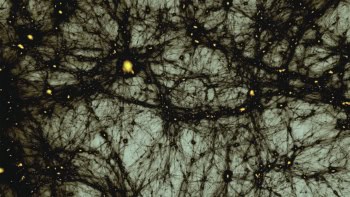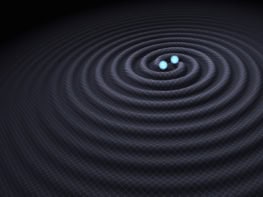Astronomers have detected the most remote galaxy ever observed, 15.5 billion light years from Earth. Light from the galaxy provides a snapshot of the universe when it was just 780 million years old. An international team led by Esther Hu of the University of Hawaii used a cluster of galaxies as a ‘gravitational lens’ to amplify the weak signal from galaxy HCM 6A. The discovery should provide valuable insights into the evolution of galaxies in the early universe (E Hu et al 2002 Astrophys. J. Lett. 568 L75).

When hot hydrogen cooled in the early universe to form galaxies, intense far-ultraviolet radiation would have been emitted as the atoms fell from excited states to the ground state. This so-called Lyman alpha emission is a tell-tale sign of galaxy formation, and has a characteristic wavelength of 121.6 nanometres. But as this radiation travels across space, its wavelength increases because the universe is expanding – an effect known as redshift. This allows astronomers to calculate the age of a galaxy and its distance from Earth.
With a redshift of 6.56, HCM 6A is the first galaxy detected with a redshift greater than six, although many galaxies have been observed with redshifts above five. The previous most distant object – a quasar – had a redshift of 6.28.
Hu’s team had detected several sources of Lyman alpha radiation using the low-resolution imaging spectrograph on the Keck II telescope in Hawaii, but these signals were too weak to be reliable. The researchers then found that a cluster of galaxies known as Abell 370 was lying directly between one of these sources – galaxy HCM 6A – and Earth. This meant that the cluster behaved as a ‘gravitational lens’ and amplified the signal by a factor of 4.5, allowing Hu and colleagues to study galaxy HCM 6A.
Since the light from HCM 6A had been shifted to infrared wavelengths, Hu and colleagues followed up their discovery by examining infrared images of the galaxy taken by the Subaru telescope, also in Hawaii. This study suggested that the galaxy was converting about forty solar masses of matter into new stars every year.
“This galaxy is forming at a time speculated to be in the ‘dark ages’ of the universe when galaxies are beginning to ‘turn on’,” said Hu. She believes that the discovery of such a distant galaxy using a ground-based telescope is encouraging for the Next Generation Space Telescope, which is due for launch next decade. “It means that there should be plenty of these distant galaxies bright enough to observe above the strong airglow of our atmosphere,” she says.



